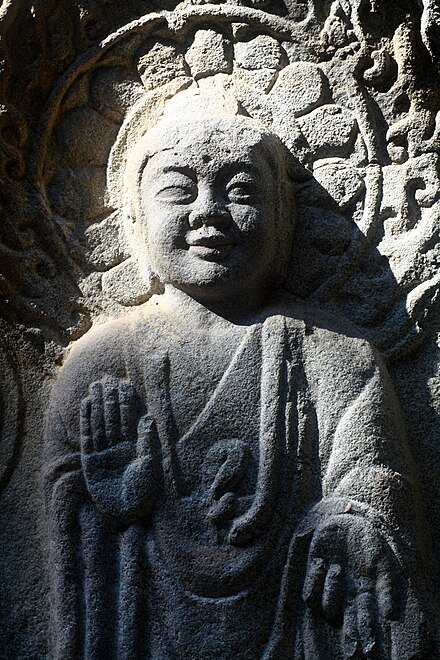Baekje smile
| Baekje smile | |
 A smiling Rock-carved triad buddha in Seosan Baekje | |
| Korean name | |
|---|---|
| Hangul | 백제인의 미소 |
| Hanja | 百濟人의 微笑 |
| Revised Romanization | Baekjeinŭi miso |
| McCune–Reischauer | Paekcheinŭi miso |
In Korean art history, the Baekje smile is the common smile motif found in Baekje sculpture and bas-relief. Baekje figures express a unique smile that has been described as both enigmatic and subtle. The smile has been also been characterized in many different ways from "genuinely glowing" to "thin and mild" to "unfathomable and benevolent".[1][2][3]
Among the Three Kingdoms of Korea, Baekje art was stylistically the most realistic and technically sophisticated. [citation needed] While Goguryeo sculpture was highly rigid, and Silla sculpture was formalized, Baekje sculpture exhibited distinct characteristics of warmth, softness, and used relaxed poses.[4] Sometimes, the Baekje style has been attributed to influence from the southern Chinese dynasties.[4] The smile gives the Baekje statues a sense of friendliness and an air of pleasantness that is rarely found in other traditions of Buddhist sculpture. The smile is considered to be unique and distinctive.[5]
See also
References
- ^ "Panga sayu sang Meditating Bodhisattva". Archived from the original on 2006-11-21. Retrieved 2006-06-21.
- ^ dynamic-korea.com
- ^ asianinfo.org
- ^ a b britannica.com
- ^ buddhamuseum.com
External links
- [1] Britannica
- Cultural Development of the Three Kingdoms
- 9th Century Korean Bronze Buddha Shakyamuni
- Meditating Bodhisattva – Musée National Des Arts Asiatiques-Guimet
- The Three Kingdoms Period of Korea – ROK embassy to the US
- Korean Influence on Japanese Culture